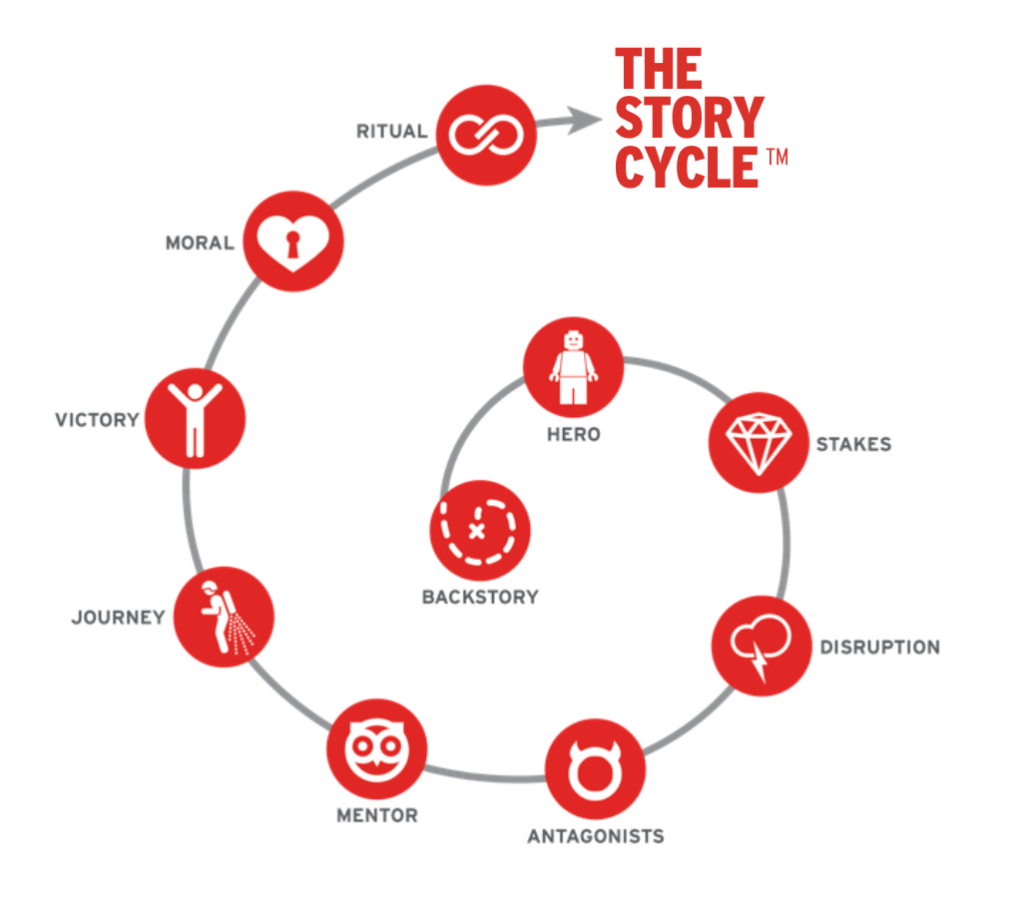
Everyone has fond memories of being read stories, as a kid. Even today, we love reading stories of inspiring individuals in the field of business, technology, e-commerce and more. We are instinctively drawn towards a good story.
Business storytelling is an appendage of branding & communication, that portrays a business through its style, features, benefits, team, skillset, vision, mission, portfolio, etc.
1. Introduction
A story is made up of an origin story, characters, challenges faced, challenges overcome and a happy ending. With business storytelling, there is a fantastic opportunity for companies to express their business vision to the world. According to ConvinceAndConvert, storytelling is probably bigger than marketing.
Every business has a story to tell. Through this ‘business storytelling guide’, we will look at why every business needs storytelling? What is the business storytelling process? Why is business storytelling important? And cover some tips for business storytelling.
Tell us what you think of this guide. Are there any more questions you would like to answer? Leave any feedback in the comments below. Let’s get started then…
2. What is Business Storytelling?
Meaning of business storytelling
Business storytelling is the art of expressing business communication as a well-defined, flow-oriented story. When we convey any business/internal communication in the form of a story, something clicks within the recipient. The impact is massive.
If you think about it, we are obsessed with stories. Even when our body is asleep; our mind keeps showing us stories through dreams. Scientifically speaking, a story that resonates, increases the level of ‘oxytocin’ in our body. Oxytocin is the ‘happy’ hormone.
When listening to a story, there is a heightened increase in empathy, compassion, and trust. Our social behavior is influenced by story listening. That is why, when a business tells a story, the whole world relates to it.
A story builds a connection. This is exactly how brands make use of business storytelling to engage with followers. When we hear about a company merging with another, our brain processes this fact and lets it go. But, when a company works with an NGO to work towards the betterment of society, we want to know more about this association.
“Purposeful storytelling is not show business, but for good business”
Peter Guber
2.1 How to Adopt Business Storytelling?
Business storytelling enables you to empathize with your target audience. Instead of simply stating company benefits or company features, layering those same benefits within a story works better. Business storytelling helps you develop a company persona.
The most obvious use of storytelling comes when a company’s representative is delivering a sales pitch. Every sales PPT will cover slides on company benefits and features. There is nothing unique. But, when a client’s pain points are resolved through business storytelling, there is a better chance for the listener to connect & react.
There are 2 sections where you can make the best use of business storytelling. The ‘About Us’ and ‘Case study’ sections/pages on your website. Here you can showcase how your product/service is best equipped to provide solutions through business storytelling.
1. About Us Page
The ‘About Us’ page is probably the most visited page on a website, after the homepage. This is because clients, consumers, investors, users, etc. all want to know more about your business/organization. They want to read your company story.
Does everybody want to know when the business was founded? How did the team tackle industry challenges? What are the ideals that the company stands for? They want to read about company success stories, etc.
The ‘About Us’ page should be written like a narrative, that describes the company’s journey in the form of a timeline. This is the best place to include a statement about the founder’s vision. All this is part of business storytelling. Describing your company ‘history’ as a company ‘story’ is the key business storytelling tactic.
People are part of any story. When watching a movie, we root for the underdog hero/heroine. We sympathize with his/her sufferings. Adding visuals, such as team photos, company outings pictures, annual conference pictures, etc. work best.
2. Case Study
An excellent way to continue fueling stories on your website is through posting company case studies. It acts as an opportunity to showcase the solutions that a company provides, to solve client problems. Add case studies that build a connection between the customer’s problem that was solved, and the reader.
Introduce your client as the hero of the case study story. Discuss the problems they faced. If the client is a market leader, highlight that. Every business needs a story to tell (remember!). Add client testimonials if possible.
The client’s name & face establish a quick connection with the reader. Business storytelling in case studies acts as an excellent marketing tool. Describe the pain points, present the solutions and tell the story. Although, a company may not exactly be a storytelling brand, by adding success stories within your website content, you add business storytelling to it.
2.2 Why is Business Storytelling So Important?
Importance of business storytelling
For a business to stand out among a sea of similar businesses, there is a need to tell stories. Business storytelling makes your content unique. Thanks to AuthenticStoryteling, we know that business storytelling is the most important aspect of reaching out to a wider audience. Your company’s PPT presentations, company annual report, company branding, internal communication, etc. all need to be aligned to business storytelling.
There is a massive amount of content that is being created and shared each day. Paid marketing is being adopted by every major organization to show their content to prospective leads. If a company does not adopt business storytelling as a mode to express their content, that content could end up getting lost over the web.
Just because a business builds a quality service/product, there is no guarantee that there will be a surge in revenue. Business storytelling differentiates a company’s service/product from the crowd. It’s so easy to plaster statistics, facts, and numbers over any business communication that goes out. The key is to take that same data and make it powerful, thoughtful, genuine, and impactful.
Business storytelling tells a story that impacts people, simplifies business information, and provokes a human response. No other brand can copy your business storytelling narrative. It remains sharable and unique.
Business storytelling increases your brand’s favorability. A story can easily be retained compared to 20 different pieces of fact. Any business communication needs to ask the question, “What does your company want to be remembered for?”. “Which message is being portrayed to the audience?”.
Business storytelling can evoke feelings within your audience. Emotions always drive action more than logic. Begin conversations, look for engagement, and try to connect. Business storytelling looks to build a relationship between the brand and the customer. Once that trust is built, customer retention becomes easier.
2.3 What is the Business Storytelling Process?
Image Credit – The Business of Story
We have established above, that business storytelling is an art. Art breeds creativity and skill. Business storytelling, like art, is a process. A process to create the perfect brand a consumer can relate to. Every artist follows a creative process. Likewise, the business storytelling process needs to have a clear goal. The goal is to express company communication, facts, figures, etc. through a believable story. The business storytelling process is comprised of the following steps:
1. Understand your Audience
Everyone loves a story. But, to identify how many out of everyone are your target audience is the key. How many will read your business story? How many would benefit from it? How many will respond to any call-to-action within your business communication? Before creating a compelling story, you need to get clarity on your target audience.
Creating a user persona is crucial to the success of your story. You need to craft content that can be viewed, read or heard by your audience. You need to research about what mode of content works best. Get this data before setting up the foundation of your story.
2. Prepare the Core Message
The quantity of content does not matter. The content could stretch up to 5 pages, 4000 words or 25 minutes in length. It doesn’t matter. The content must contain a core message. Unless you finalize a core message, you cannot progress in the business storytelling process.
3. Decide the Story Type
Not all stories are the same. Each story touches a different emotion. Some stories can evoke a sense of assurance while some evoke a sense of warmth. As the core message is already decided, the weaving of a story simply adds a layer to the message.
An effective business story should:
- describe how successful a method was in the past, and the same can happen to prospective clients
- avoid describing every intricate detail. Don’t exaggerate too much. Make the reader focus on the solution/action
- containing practical or cost-effective solutions. Human struggle, setback, and success all work well
- and making use of authentic values, that tap into human characters, emotions, and situations
- be share-worthy so that the reader can let others feel the same way they feel
- feature a trial-and-error situation, that takes effort, patience and skill to get solved
4. Add a CTA
The call-to-action can be anything from asking the readers to sign up on your website, make payments for a cause, subscribe to newsletters, purchase a product or hire their services.
2.4 What are the Benefits of Business Storytelling?
Advantages of business storytelling
Business storytelling aids in removing marketing as a sole business differentiator. Going by what Wordstream has to say, any story that is not conveyed well, won’t be appealing to an audience
Every competing business is looking to go beyond standard marketing strategies. But there are also other benefits of business storytelling. Some of them are:
1. Bridging Brand & People
Stories act as a universal language, for effective communication. If we simply liken a business with elements of a story, such as ‘the hero’, ‘the obstacle’, ‘the fight’ and ‘the win’, readers connect better. Even a diverse target audience can relate to well-crafted business stories.
2. Simplifying Business Jargon
It is difficult to explain brand-new concepts to a user or reader. Stories help us understand a concept better. Real-life examples, such as case studies, testimonials, and customer reviews, leave a lasting impact.
3. Inspiring & Motivating People
When businesses adopt storytelling as a strategy to convey a message, consumers perceive these actions as authentic and transparent. Baring both the positives and negatives of a business process builds brand loyalty.
2.5 What are Some Effective Business Storytelling Tips?
Certain rules must always set business storytelling, convey authenticity, be clear, and be consistently engaging. According to Forbes, there needs to be a strategy involved, when driving people onboard via your business story.
1. Storytelling Parameters
There needs to be a clear context for any business communication. Parameters ensure the story is engaging and tight. Establish the purpose and reason of narrating the story.
2. Authentic Storytelling
Over-the-top bragging won’t work with customers. In case, there is nothing earth-shattering about your business communication or business history, don’t worry. Stay true to your experiences and it will be awarded by the audience.
3. Storytelling Outcome
A thought-provoking message must have a clear outcome. Lessons must be learned when any business communication becomes a story to tell. There is an instant brand connection as well.
4. Consistent Storytelling
A business message that is unorganized or grammatically incorrect, leads to confusion. There are chances that the same message will be published on multiple mediums. Ensure that the slogan, call-to-action, color theme, and brand logo, are all the same. The audience will relate to the brand image, after viewing the message across all channels.
About Synapse.co…
After such a long blog post, we wouldn’t want to harp on about our services. But, for those who want to know what we do;
We are a Goa-based, business communication agency that offers the best services for digital marketing, advertising, content marketing, and brand storytelling.
Our copywriters, graphic designers, and project managers provide the best services in content & digital marketing and business communication.
Synapse’s brand design team works as per your brand guidelines to create an impactful brand identity. We work on crafting impactful brand experiences for every business.
We ensure better internal communication between you, your employees, your clients, your customers & your investors. Improve your company workforce efficiency and grow your profit margin through creative business communication.
Improve your company sales targets by designing marketing collateral that attracts your customers and clients. Increase business sales by opting for effective content & marketing strategies.
We help businesses fix communication problems between clients, prospects & employees. With our bespoke content marketing services, content creation will never be a problem.
If you want to embed business storytelling into your business’ mundane internal or external business communications, then hire us. You won’t regret it…hit the button below to get in touch with someone from our team












